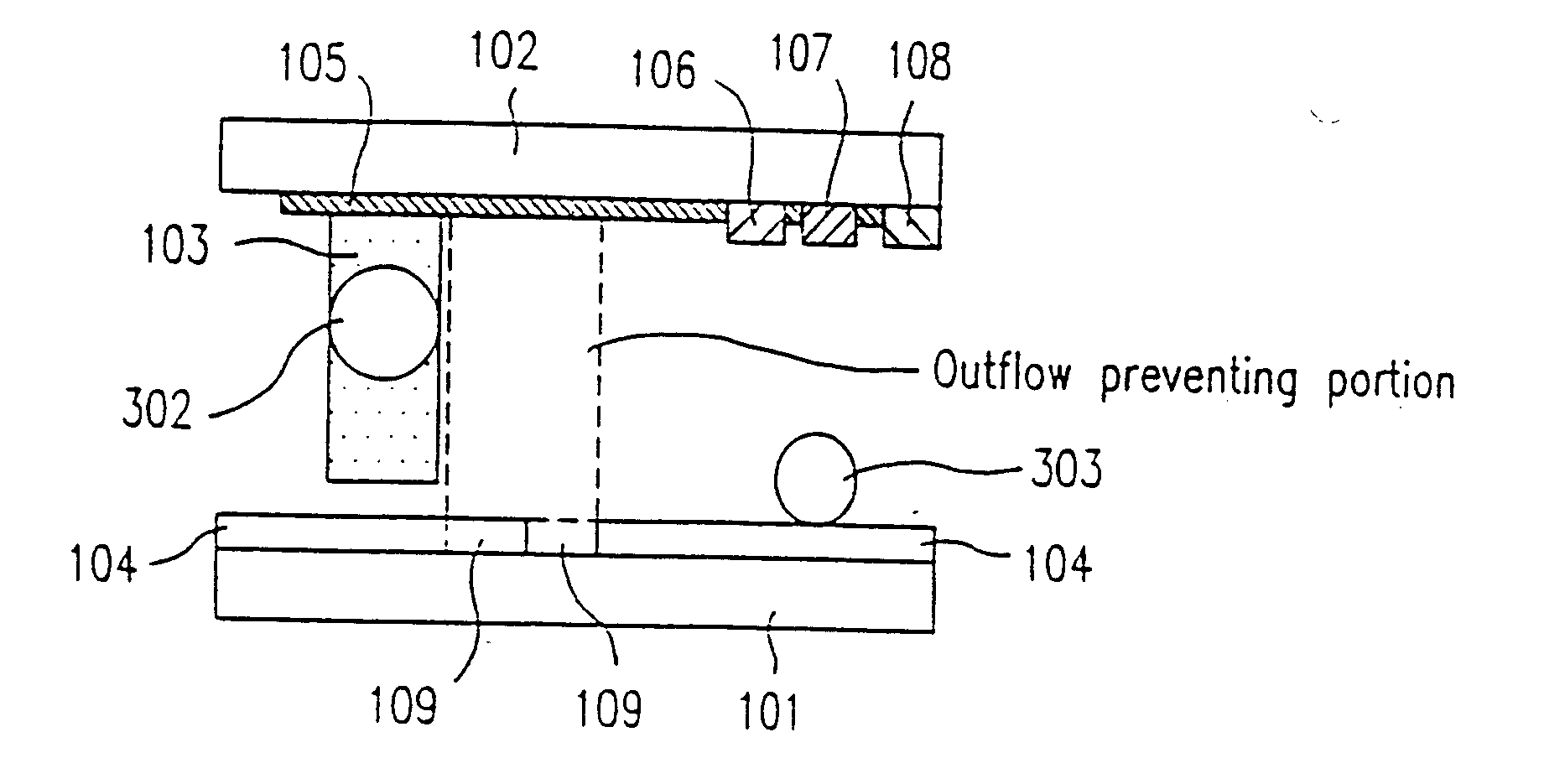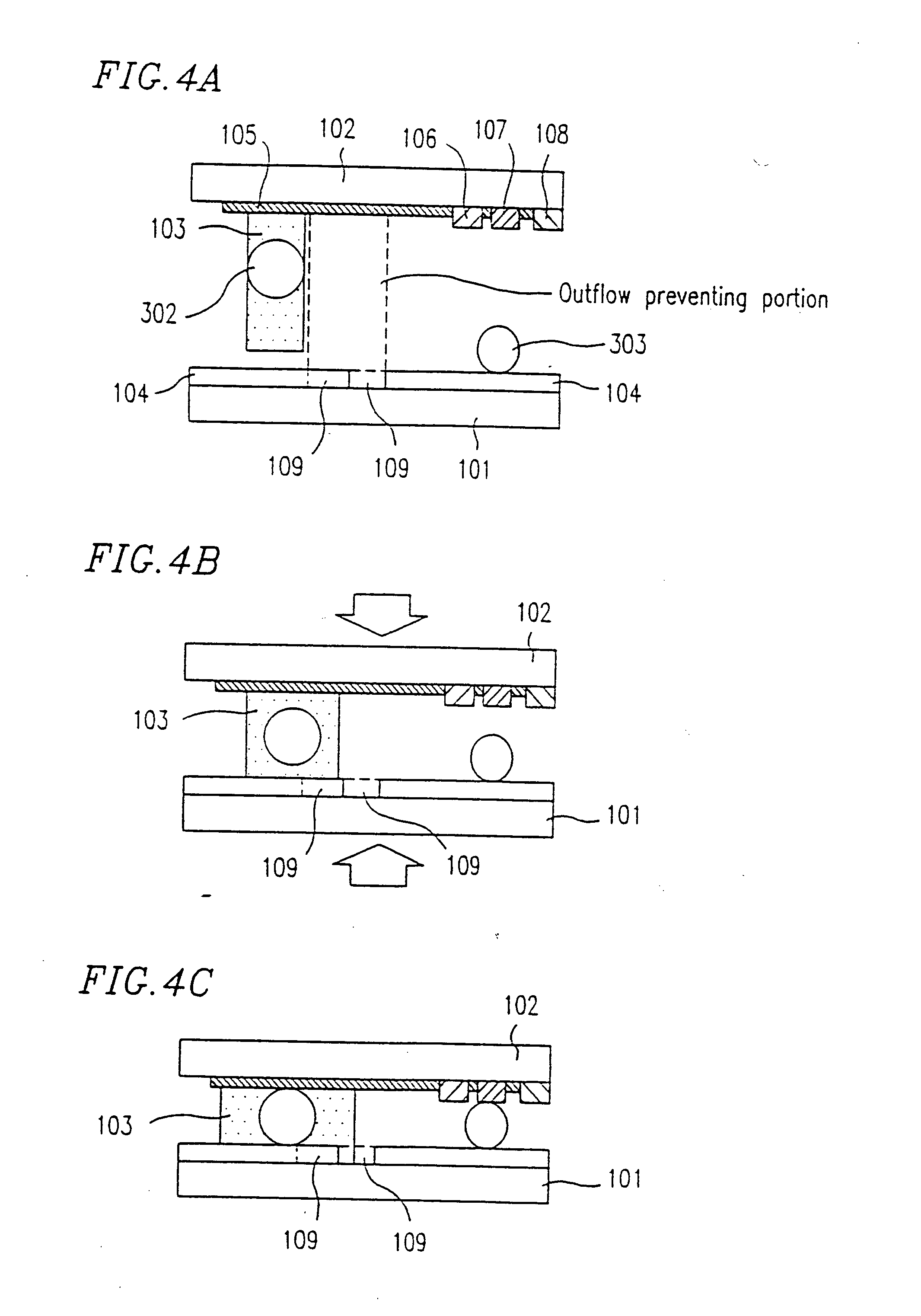Liquid crystal display device
a liquid crystal display and display device technology, applied in non-linear optics, instruments, optics, etc., can solve the problems of poor display, poor mechanical strength, poor display, etc., and achieve excellent mechanical strength and sealing properties, and convenient production process
- Summary
- Abstract
- Description
- Claims
- Application Information
AI Technical Summary
Benefits of technology
Problems solved by technology
Method used
Image
Examples
embodiment 1
[0097]FIG. 1 is a schematic cross-sectional view showing the vicinity of the sealing material of a liquid crystal display device according to a preferred embodiment of the present invention, and FIG. 2 is a schematic plan view of the liquid crystal display device. FIG. 3 is a schematic cross-sectional view showing the TFT portion of the liquid crystal display device.
[0098] The liquid crystal display device comprises a TFT substrate 101 and a color filter substrate 102 both of which are opposite to each other, and a sealing material 103 formed in the periphery portion between the substrates 101 and 102. Preferably, the sealing material 103 is continuously formed on the four sides of the periphery portion. A liquid crystal layer 110 is interposed between the substrates 101 and 102 and is sealed by the sealing material 103. The liquid crystal layer may contain any suitable liquid crystal material. The substrates 101 and 102 are disposed at the prescribed cell gap by using an intra-sea...
embodiment 2
[0123] This embodiment provides a case where a black matrix 301 of the color filter substrate 102 is made from the same resin material as that of the color layers 106, 107 and 108, as illustrated in FIG. 12. The outflow preventing portion 109 is formed in the interlayer insulating film 104 of the TFT substrate 101 as with Embodiment 1.
[0124] In this case, since the black matrix is formed from a resin material, it is possible to increase the thickness of the black matrix 301. For example, the thickness of the black matrix is about 15000 angstroms in this embodiment. Therefore, it is possible to flatten the surface of the color filter. When a black matrix made from a resin material is used, the cell gap of the liquid crystal layer portion will be substantially equal to that of the sealing portion, unlike a case of using a black matrix made from a metal (for example, Cr). Thus, a difference in level between the black matrix 105 made from Cr (i.e., not made from a resin) and the color ...
embodiment 3
[0132] The following illustrates an active-matrix-type liquid crystal display device which is still another embodiment of the present invention. First, the circuit of the active matrix-type liquid crystal display device is illustrated with reference to FIG. 14. Gate bus lines 4 which are scanning lines are connected to a plurality of scanning terminals 2 located in the linear direction, while source bus lines 8 which are signal lines are connected to a plurality of signal terminals 6 located in the row direction. Each of the gate bus lines 4 and each of the source bus lines 8 cross each other (substantially at a right angle in this embodiment). A display pixel 10 is formed in a region surrounded by the adjacent gate bus lines and the adjacent source bus lines. The display pixel 10 comprises a pixel electrode 12, a switching element (an active element) 14 such as TFT, and a storage capacitor 16. The pixel electrode 12 is opposite to a counter electrode 18. The storage capacitor 16 is...
PUM
| Property | Measurement | Unit |
|---|---|---|
| diameter | aaaaa | aaaaa |
| particle size | aaaaa | aaaaa |
| thickness | aaaaa | aaaaa |
Abstract
Description
Claims
Application Information
 Login to View More
Login to View More - R&D
- Intellectual Property
- Life Sciences
- Materials
- Tech Scout
- Unparalleled Data Quality
- Higher Quality Content
- 60% Fewer Hallucinations
Browse by: Latest US Patents, China's latest patents, Technical Efficacy Thesaurus, Application Domain, Technology Topic, Popular Technical Reports.
© 2025 PatSnap. All rights reserved.Legal|Privacy policy|Modern Slavery Act Transparency Statement|Sitemap|About US| Contact US: help@patsnap.com



